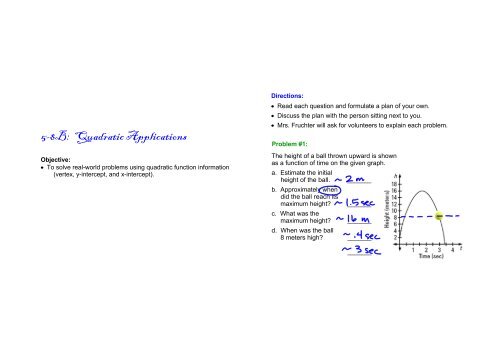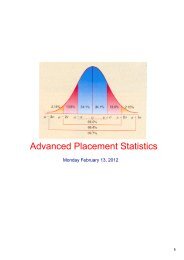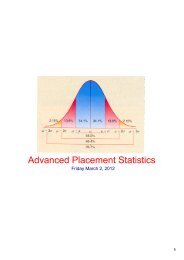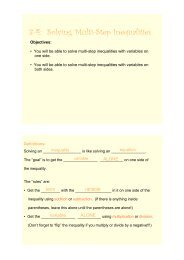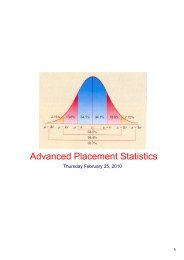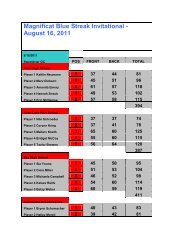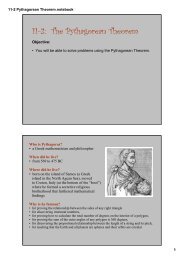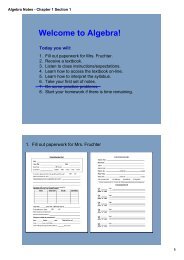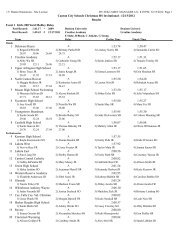Notes 5.8B Quadratic Applications - Kenston School District
Notes 5.8B Quadratic Applications - Kenston School District
Notes 5.8B Quadratic Applications - Kenston School District
You also want an ePaper? Increase the reach of your titles
YUMPU automatically turns print PDFs into web optimized ePapers that Google loves.
5-8B: <strong>Quadratic</strong> <strong>Applications</strong><br />
Objective:<br />
• To solve realworld problems using quadratic function information<br />
(vertex, yintercept, and xintercept).<br />
Directions:<br />
• Read each question and formulate a plan of your own.<br />
• Discuss the plan with the person sitting next to you.<br />
• Mrs. Fruchter will ask for volunteers to explain each problem.<br />
Problem #1:<br />
The height of a ball thrown upward is shown<br />
as a function of time on the given graph.<br />
a. Estimate the initial<br />
height of the ball.<br />
b. Approximately when<br />
did the ball reach its<br />
maximum height?<br />
c. What was the<br />
maximum height?<br />
_______<br />
_______<br />
_______<br />
d. When was the ball<br />
8 meters high? _______<br />
_______
Problem #2:<br />
Refer to the diagram given.<br />
Calculate the area of each region.<br />
(Be sure to write the answers in standard form.)<br />
a. Area of the shaded rectangle:<br />
Problem #3:<br />
Suppose a park district plans to build a rectangular playground<br />
that is 80 meters by 60 meters with a walkway that is w meters<br />
wide around it.<br />
a. Label the diagram to<br />
represent this situation:<br />
________________________________<br />
b. Area of the larger rectangle:<br />
________________________________<br />
c. Area of the unshaded region:<br />
b. Write an expression in standard form for the total area of the<br />
playground and the walkway.<br />
________________________________<br />
________________________________<br />
c. Find the total area if w = 3.
<strong>Quadratic</strong> Application <strong>Notes</strong>:<br />
Vertical Motion Formulas<br />
When units are in feet:<br />
When units are in meters:<br />
h = t =<br />
v = c =<br />
EX #2:<br />
Suppose a water balloon is dropped from<br />
the top of a 79 foot tall tree.<br />
a. Write an equation that describes the relationship<br />
between the height of the ball above the ground<br />
(h) and the time (t) in seconds.<br />
b. Use the table below and the<br />
grid at the right to graph your<br />
equation from part a.<br />
EX #1:<br />
Suppose a ball is thrown upward from a height of 5 feet with an<br />
initial velocity of 30 ft/sec.<br />
a. Write an equation relating the time (t) in seconds and the<br />
height (h) of the ball in feet.<br />
b. Find the height of the ball after 1.5 seconds.<br />
c. Using your graph, estimate how long it would take the ball to reach<br />
the ground. Explain your reasoning.
EX #4:<br />
Michael threw a water balloon upward at a<br />
speed of 10 m/sec while standing on the roof<br />
of a building 12 meters high.<br />
a. Write an equation relating the time in seconds and the height of<br />
the balloon in meters.<br />
EX #3:<br />
On the graph, the height (ft) of a baseball hit upward is<br />
shown as a function of time (sec).<br />
a. What was the initial height<br />
of the ball?<br />
b. What was the height of the balloon after 2 seconds?<br />
c. Assume that the balloon did not land on the roof,<br />
about how long did it take for the balloon to reach the ground?<br />
b. When did the ball reach its<br />
maximum height?<br />
c. What was the maximum<br />
height?<br />
d. When was the ball 30 ft<br />
in the air?<br />
e. When did the ball hit the ground?
EX #5:<br />
A model rocket was launched straight up with an initial velocity<br />
of 75 m/sec. The launch pad was 2.3 m off the ground.<br />
a. Write an equation relating the<br />
time (t) and the height (h).<br />
EX #6:<br />
A square room and a rectangular room require the same amount of<br />
carpeting. The length of the rectangular room is 8 feet less than twice<br />
the side of the square room. The width of the rectangular room is 3<br />
feet less than the square's side.<br />
b. When will the rocket reach a height<br />
of 100 m? (Use your calculator.)<br />
a. Let x represent the length of the side of the square.<br />
Write expressions for the dimensions of the rectangle:<br />
c. When will the rocket hit the ground?<br />
length = ____________<br />
width = ____________<br />
b. Write an equation that represents the relationship between the<br />
square and the rectangle. Solve for x.<br />
c. Find the dimensions of both figures.<br />
square = ____________<br />
rectangle = ____________
EX #7:<br />
Sherman hit a fastball thrown by Austin.<br />
Let x be the distance on the ground in feet<br />
of the ball from home plate and h(x) be the<br />
height in feet of the ball at that distance.<br />
Suppose the path of the ball is described<br />
by the function:<br />
a. Define your variables:<br />
x = ____________<br />
y = ____________<br />
b. How far from the plate, along the ground, was the ball when it was<br />
again at the same height at which Sherman hit it?<br />
c. How far from the plate, along the ground, was the ball when it was<br />
100 feet high?<br />
d. The fence is 405 feet from home plate, and it is 12 feet high.<br />
Did the ball go over the fence? __________ Prove it.


